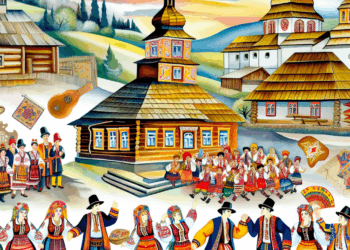Introduction
Bukovina is a unique region located at the crossroads of Eastern and Western Europe. Its history is filled with events that have shaped cultural and ethnic diversity, but many of these facts remain in the shadows of better known historical moments. This article aims to highlight little-known but significant aspects of Bukovina’s history with a focus on the princely times, the Austrian Empire period, the interwar years and the Soviet era.
Princely times (X-XIV centuries)
1. formation of the principality
By the beginning of the X century, the first Slavic settlements began to form on the territory of Bukovina. In the X-XI centuries the region was under the influence of Kievan Rus’. The establishment of princely power is associated with the name of Prince Svyatoslav, who directed his efforts to strengthen the borders and expand the territories. Nevertheless, historical sources poorly cover the details of governance and life of the principality during this period.
2. Prince Basil and rise of cultural life
The existence of princely power in Bukovina continued until the 13th century, when various local princes ruled here. One of the most famous is Prince Vasiliy of the Galicia-Volhynia dynasty, who in the 13th century introduced a series of reforms that strengthened the state and promoted trade. These changes initiated cultural integration, which later manifested itself in the construction of the first temples and fortifications.
3. pagan heritage
An interesting fact is the existence of pagan customs that persisted even under the conditions of Christianisation. Some of them, such as rituals related to farming and the change of seasons, had significance for the local population and show the resilience of traditions in the face of new religious norms.
Period of the Austrian Empire (1775-1918)
1. Accession to the Austrian Empire
In 1775 Bukovina was annexed to the Austrian Empire. This transition had a huge impact on the economy and social structure of the region. The reforms introduced by its emperor Joseph II led to the development of infrastructure and education.
2. ethnic diversity
Under the rule of the Austrian Empire, an ethnic mosaic was formed in Bukovina, where Ukrainians, Romanians, Jews, Poles and other peoples coexisted. This cultural exchange contributed to the formation of the region’s unique cultural landscape. For example, in Chernivtsi, the capital of Bukovyna, iconic and educational institutions such as Chernivtsi University were built in the 19th century, which became one of the largest educational institutions in Eastern Europe and later became a UNESCO World Heritage Site.
3. economic prosperity
Bukovina experienced an economic boom during this period, thanks to the development of agriculture and trade. The timber industry was in particular demand, as the region was rich in forests. The wine industry was also developing. However, despite economic prosperity, social inequality remained a problem, leading to periodic unrest.
Interwar years (1918-1939)
1. Finding oneself in the new state
After the First World War, Bukovina became part of Romania. This period was characterised by a search for identity among the multi-ethnic population. One of the interesting poets who reflected this era was the Ukrainian poet Oleksandr Oles, whose works covered the themes of homeland and national identity.
2. Social reforms
During the interwar period, the Romanian government introduced a number of social reforms aimed at improving the lives of the peasantry and increasing access to education. Local self-government was also developed during this period, which strengthened the position of local intellectuals.
3. Cultural achievements
One of the notable events of this time was the opening of the house-museum of the “Chernivtsi Academy”, where famous writers, scientists and artists gathered. Art and culture in Bukovina became dynamic, as evidenced by the increase in the number of theatres, exhibitions and scientific clubs.
Soviet era (1940-1991)
1. Accession to the USSR
In 1940, Bukovyna rejoined the USSR. This event marked the transition to a new system, different from the market economy. Collectivisation and industrialisation began, which changed the traditional way of life.
2. Repressions and famine
The most tragic page of this period is the political repressions and famine, which affected a large part of the population, including both Ukrainians and Romanians, as well as Jews. Numerous deportations and shootings left a deep trace in the memory of the people.
3. Development of education and science
Despite the hard times, the 1960s saw a qualitative leap in education. During this period, the Chernivtsi State University was founded and became an important scientific and educational centre. Teaching was conducted in several languages, which contributed to the preservation of cultural heritage and the integration of different ethnic groups.
4. Culture and art
The second half of the 20th century saw a revival of cultural life in Bukovina. The O. Kobilyanska Drama Theatre became a centre of art, attracting the attention not only of locals but also of foreign visitors. The plays presented here enriched the cultural landscape of the region and became a platform for discussing social topics.
Conclusion
The history of Bukovina is rich in events, many of which remain in the shadow of better known historical processes. From princely times to the Soviet era, each period has made a unique contribution to shaping the cultural and social identity of the region. Bukovina is not just a space isolated from the rest of the world, it is a complex mosaic in which the cultural, political and historical facets of different nations and peoples are gathered. The study of these aspects not only enriches our understanding of the region’s history, but also helps us realise the importance of preserving cultural diversity in the modern world.








